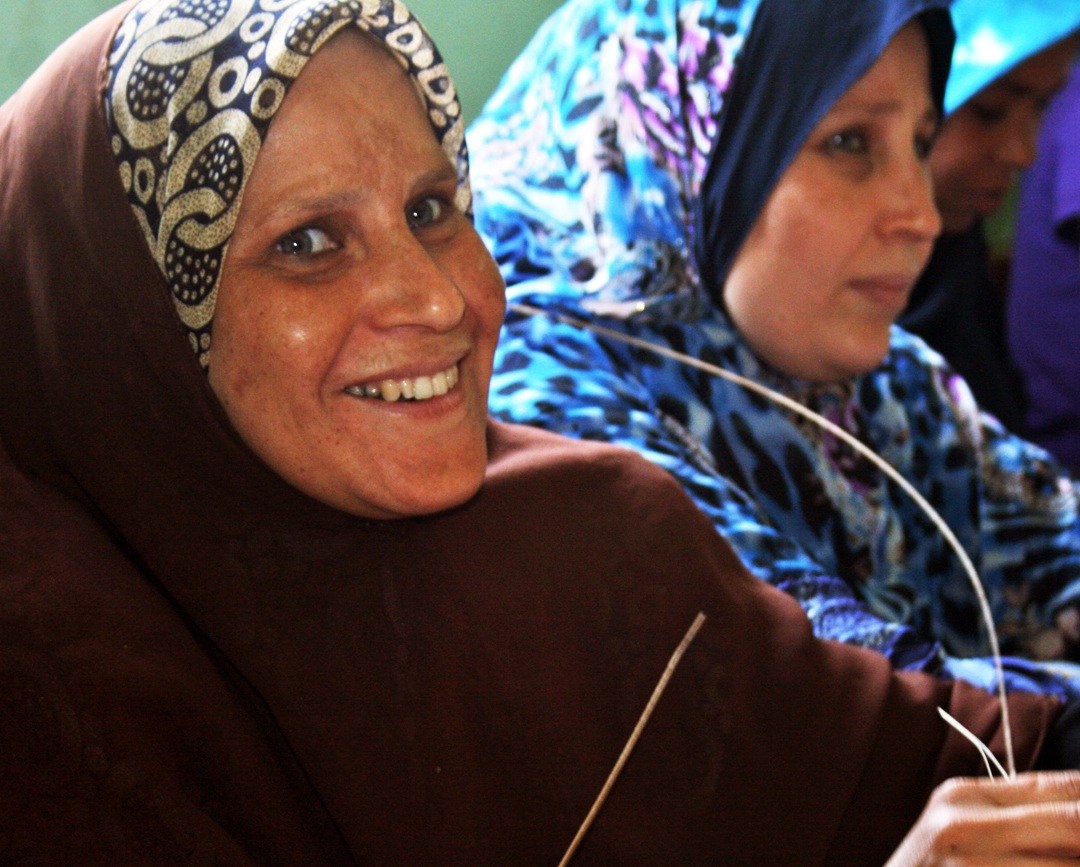

Building new communities in the ruins of the world’s oldest

By Olfa Tantawi
Times are tough for Om Ahmed and other residents of Manshiet Dashur, a rural village at the foot of two of the oldest and best-preserved monuments in Egypt, the Bent and Red Pyramids.
Climate change has badly affected the quality of land in this predominantly agricultural community; a burst in population has brought an increase in poverty and unemployment, and the political turmoil in Egypt has depressed tourism, a big source of revenue.
But Om Ahmed, an energetic woman in her mid thirties and a mother of five, is learning to make a livelihood out of a local treasure: the leaves of the palm trees that flourish here. With 15 other women, she recently attended a handicrafts training workshop, part of a UN programme financed by the MDG-Fund to develop tourism and boost incomes, particularly among women and youth. The palm leaves, once soaked in water, can be fashioned and woven into objects, fashion accessories and rugs.
“Once we master the skills, we, the women of Dahshur, will train our daughters, friends and family. We are all mothers and wives, and these activities are ideal since we can work and produce from home,” said Om Ahmed, adding that she is fully supported in this endeavor by her husband, a former phosphate mine worker who was forced to retire due to the high volume of residuals in his lungs.
The MDG-F-funded programme is aimed at protecting the Dashhur pyramids while encouraging tourism-based sustainable development. It focuses on improving the livelihoods and working conditions of the local population through creative industries that particularly employ women and young people, along with the development of small and micro enterprises.
The programme is also empowering local residents to manage Dahshur’s cultural heritage through the preservation of the area’s unique seasonal lake and monuments and the development of community-led conservation activities.
Protecting a cultural heritage
When the Egyptian revolution erupted in January 2011, thieves invaded the monuments area to steal precious antiques. “We stood up to the thieves and later, with the help of UNESCO, we organized a march and a cleanup event to raise awareness among our people that these monuments are our pride, treasure, heritage of the past and most evidently make part of the future as well” said Ashraf Mansy, the elected president of the Dahshur Forum, a newly established NGO with active representation from all five villages that surround the monuments.
“We have our own plans and dreams and we act as a community,” said Marwa Shahin, a young women in her mid 20’s who is a member of the Dahshur Forum. “Through the Forum and the multitude of activities, people from the different villages got to know each other, and now they understand better the meaning of joining efforts and working together.” Several NGOs to develop tourism and support cultural entrepreneurship have sprung up, and the Ministry of Tourism has committed 50 million Egyptian pounds to developing infrastructure in the area, including roads.
The joint UN programme is also providing intensive three-month creative industries trainings; so far, 205 residents have been trained, 160 of them women. 300 men and women have received entrepreneurship training and a micro-credit programme has extended small business loans to 157 people, a third of them women. An initiative to reduce unemployment by linking residents and potential employers has trained and placed 40 men and women in the garment sector.
Om Ahmed, like many Dahshurians, expressed optimism about the new culture of entrepreneurship in the community and the efforts to raise awareness among residents about the area’s potential as a center of tourism, culture and crafts.
Looking up from her work at the UN crafts training, where she and her colleagues were bending and weaving palm leaves into elegant ladies’ handbags, she said: “One day people around the world will look at items like these with a ‘Made in Dahshur’ label attached.” She added playfully, “We will even compete with China!”
Working together to reduce poverty
The joint UN programme “Dahshur World Heritage Site Mobilization for Cultural Heritage for Community Development" was created by the Millennium Development Goals Achievement Fund in 2009 with a budget of $3 million, and is a collaboration between the Egyptian government and five UN agencies (WTO, UNDP, ILO, UNESCO, UNIDO).
The joint programme part of the MDG-Fund’s work to assist countries in achieving the anti-poverty Millennium Development Goals, and to ensure that the world’s most vulnerable and marginalized citizens have an equal opportunity to develop and build livelihoods for themselves.